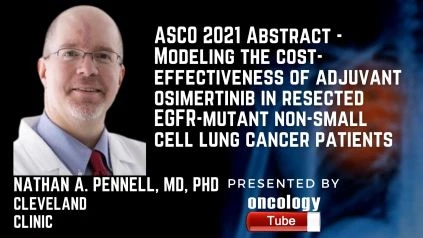Nathan A. Pennell, MD, Ph.D., FASCO, Vice Chair of Clinical Research and Director, Lung Cancer Medical Oncology Program Cleveland Clinic Taussig Cancer Institute Clinic speaks about the ASCO 2021 Abstract – Modeling the cost-effectiveness of adjuvant osimertinib in resected EGFR-mutant non-small cell lung cancer patients.
Link to Abstract –
https://meetinglibrary.asco.org/record/198656/abstract
Background information:
Based on the ADAURA trial’s DFS benefits, adjuvant Osimertinib (Osi) was recently approved for resected EGFR-mutant non-small cell lung cancer (NSCLC). Prior studies of adjuvant EGFR inhibitors that resulted in improved DFS but not overall survival (OS) have sparked debate over early clinical implementation due to the high drug costs. The purpose of this study is to assess Osi’s cost-effectiveness (CE) in this situation.
Methodologies:
We built Markov models using post-resection health state transitions and digitized DFS data from the ADAURA trial to compare the cost and quality-adjusted life-years (QALYs) of 3 years of adjuvant Osi versus placebo in the ADAURA patient population of stage IB to IIIA NSCLC patients over a 10-year time horizon in the ADAURA patient population of stage IB to IIIA NSCLC patients. All patients who progressed to the stage of progressive disease (PD) were re-treated with Osi. Medicare reimbursement data and literature were used to calculate cost and utility values (Table). The CE threshold was set at three times the GDP per capita. Because the impact of adjuvant Osi on OS has yet to be reported, deterministic sensitivity analyses were performed to assess the impact of a range of OS benefits.
The following are the outcomes:
Adjuvant Osi had an incremental cost-effectiveness ratio (ICER) of $317,119.90 per QALY gained. Osi has higher initial costs than the placebo group for the first three years but then drops to the same level as the placebo group after year four, with similar costs after year seven. PD-related expenses are higher in the placebo group for the first 6.5 years. The average pre-PD, post-PD, and total costs in the placebo group were $2,388, $379,047, and $502,937, respectively, compared to $505,775, $255,638, and $800,697 in the Osi group. QALYs were consistently higher in the Osi arm. Between a 25-30 percent OS benefit of Osi over placebo, sensitivity analysis using incremental OS gains reaches the CE threshold of $195,000, reaching the CE threshold of $195,000. An ICER of $115,419 was obtained by applying a 50% discount to the Osi annual cost.
Final Thoughts:
If you’re willing to pay $317,119 more per QALY gained, 3 years of adjuvant Osi is more cost-effective than placebo, with the majority of costs accruing as drug costs in the first three years. With an OS benefit of 25-30% over placebo, this strategy became cost-effective. The ICER is significantly improved when Osi annual costs are discounted. Because of the immaturity of the ADAURA OS data and model limitations, further research into the true cost-effectiveness of adjuvant Osi will be required.

